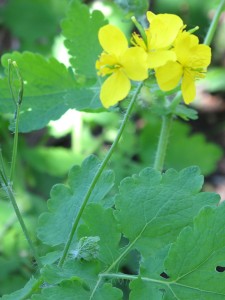Greater celandine, or swallow wort, has an ancient association with the common European swallow; it was believed that mother birds dropped the juice of the celandine into the eyes of their blind fledglings. The plant and the bird were linked for many centuries, and celandine’s reputation as a sovereign remedy for clearing eyes and sharpening the sight outlasted the Middle Ages.?? Photographs by Corey Eilhardt
It seems to be called Chelidonia because it springs out of the ground together with ye swallows appearing, & doth wither with them departing. Somme have related that if any of the swallowes’ young ones be blinde, the dames bringing this herbe, doe heale the blindness of it.
???Dioscorides, De Materia Medica, Book II: 211
The greater celandine, Chelidonium majus is native to Europe and western Asia, but is widely naturalized in waste places in the eastern United States, where it is commonly known as “swallow wort.” For more information, see the U.S.D.A. Plants Database. (Chelidonium majus is characterized as greater celandine, to distinguish it from an altogether different species, Ranunculus ficaria, widely known as lesser celandine.)
The ancient herbalist Dioscorides proffers a plausible explanation of this pretty member of the poppy family’s name???it is called after the common swallow (Hirundo rustica), or chelidon in ancient Greek, because the life cycle of the plant coincides with the migratory habits of the bird. The second, more fanciful interpretation he records was destined to a long life in herbal literature. (Jerry Stannard, an authority on the ancient and medieval pharmacopeia, doubted that the plant was originally named after the swallow and thought it more likely that the bird and the plant were conflated because of a similarity in their names.) The belief that mother birds dropped celandine juice into the eyes of their blind fledglings was accepted by the Roman natural historian Pliny, who regarded celandine as one of the chief examples of the discovery of the medicinal virtue of a plant by an animal, and the story was repeated by medieval encyclopedists such as Bartholomaeus Anglicus.
In the chapter devoted to celandine in the 1597 edition of The Herball, or General History of Plants, John Gerard quotes Dioscorides only to discount both explanations of the name???Gerard observes that celandine grows all through the year and declares that the belief that the swallow makes medicinal use of its juice is “vaine and false.” On the authority of Aristotle, Gerard did believe that the eyes of fledgling swallows were capable of regeneration, even if their eyes were gouged out, without any recourse to a medicament. Gerard nevertheless upholds the ancient reputation of celandine as a sharpener of the sight, capable of cleansing and removing any slimy things that cling to the eyeball.
The curative powers attributed to celandine were not limited to the treatment of the eyes. Although Pliny the Elder recognizes it as a wonderful cure for eye troubles, especially when cooked with honey in a brazen vessel (Historia naturalis XV 142), Pliny also remarks on its usefulness for the treatment of sores, suppurations, and ulcers (XV 142, XXVI 141).
Hildegard of Bingen, who calls the herb by its German name, grintwurz, emphasizes the hot and poisonous nature of celandine juice and warns that it is not to be taken internally, but she does recognize its benefits as a cleanser: “Whosoever eats, drinks, or touches something unclean, from which his body becomes ulcerous, he should take old fat and add some celandine juice to it. He should crush this and liquefy it in a small dish. When he rubs himself thoroughly with this unguent he will be healed” (Physica, CXXXVIII).
The fifteenth-century Herbarius Latinus concurs as to the hot, dry nature of?? ‘chelidon,’ describing it as warm and dry in the fourth degree. It is said to dissolve, consume, and draw out, and to removes freckles and scabies as well as spots from the cornea.
Modern authorities affirm the toxic properties of celandine (see Poisonous Plants of Pennsylvania), and the irritating nature of the sap, which can cause contact dermatitis. The plant’s reputation for dissolving and removing spots and excrescences is doubtless the basis for celandine’s considerable and still extant reputation as a wart cure. The caustic sap is applied directly to the wart. Maude Grieve warns that care should be taken not to get celandine juice on healthy skin (see reference), but I’ve often dabbed the sap on my hand in order to demonstrate the brilliant color when discussing the use of celandine as a substitute for gold in medieval manuscript illumination. I myself have never experienced even the mildest irritation. Nevertheless, caution should be exercised when handling the plant.
???Deirdre Larkin
Sources:
Anderson, Frank J., ed. “Herbals through 1500,” The Illustrated Bartsch, Vol. 90. New York: Abaris, 1984.
Grieve, Maude. A Modern Herbal. 1931. Reprint: New York: Dover Publications, 1971.
Griffiths, Mark. The New Royal Horticultural Society Index of Garden Plants. Portland, OR: Timber Press, 1992.
Grigson, Geoffrey. The Englishman’s Flora. 1955. Reprint: London: J. M. Dent & Sons, 1987.
Gunther, Robert T., ed. The Greek Herbal of Dioscorides, translated by John Goodyer 1655. 1934. Reprint: New York: Hafner Publishing, 1968.
Pliny. Natural History, Vol. IV, Books XIII???XVI. Translated by H. Rackham. Cambridge, MA: Loeb Classical Library, 1945, reprinted 1960.
__________________ Vol. VII, Books XXIV???XXVII. Translated by W.H.S. Jones. Cambridge, MA: Loeb Classical Library, 1956, reprinted 1966, revised 1980.
Stannard, Jerry. “Rezeptliteratur as Fachsliteratur” (VII, 71) in Herbs and Herbalism in the Middle Ages and Renaissance. Eds. Katherine Stannard and Richard Kay. Brookfield, VT: Ashgate, 1999.
Throop, Priscilla, transl. Hildegard von Bingen’s Physica: The Complete English Translation of Her Classic Work on Health and Healing. Rochester, VT: Healing Arts Press, 1998.
Tags: Aristotle, Bartholomaeus Anglicus, celandine, Chelidonium majus, De Materia Medica, Dioscorides, grintwurz, Herbarius Latinus, Hildegard of Bingen, Hirundo rustica, John Gerard, Physica, Pliny the Elder, Ranunculus ficaria, swallow


